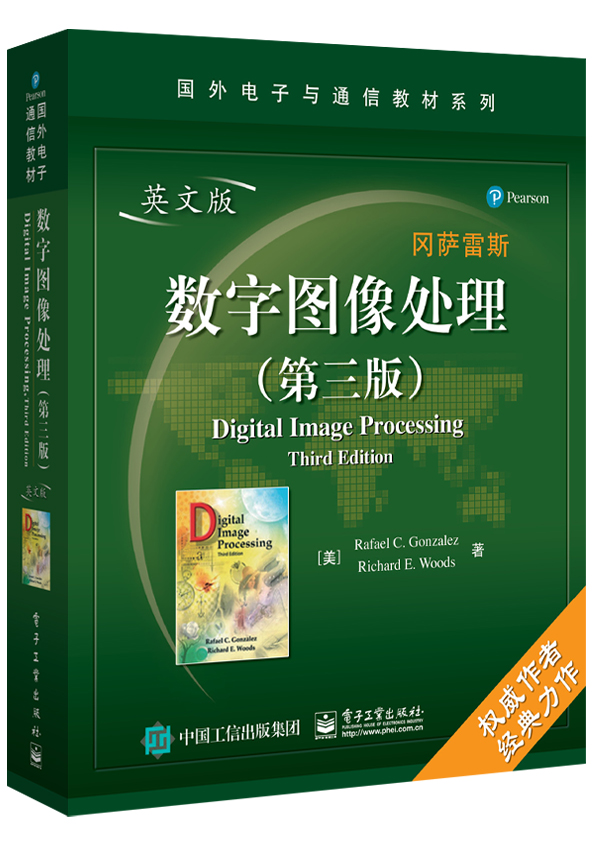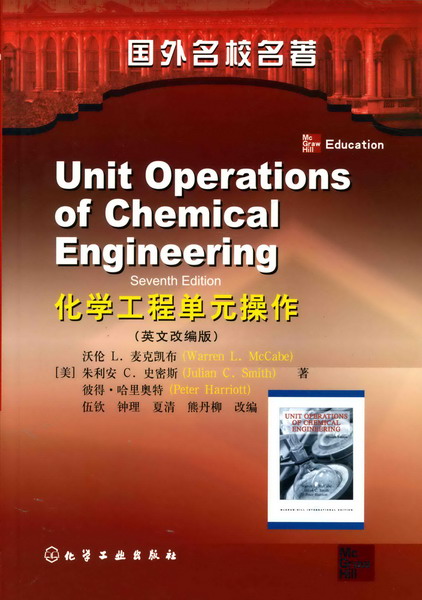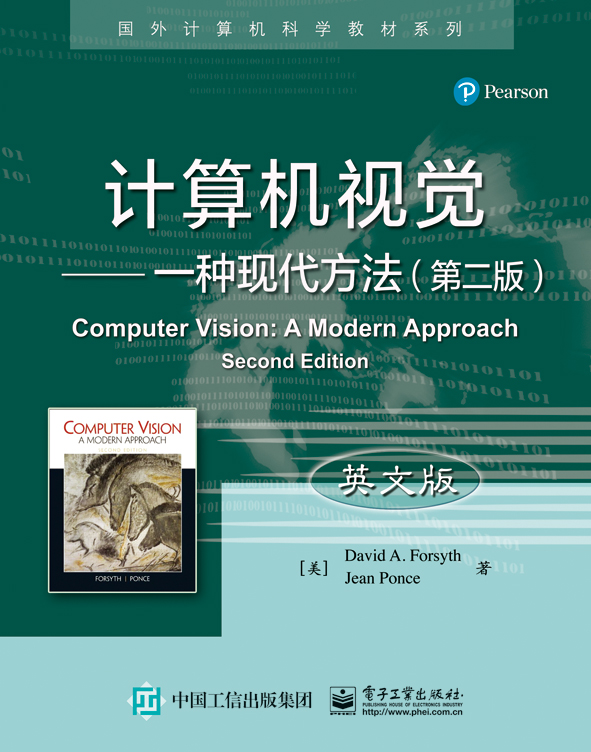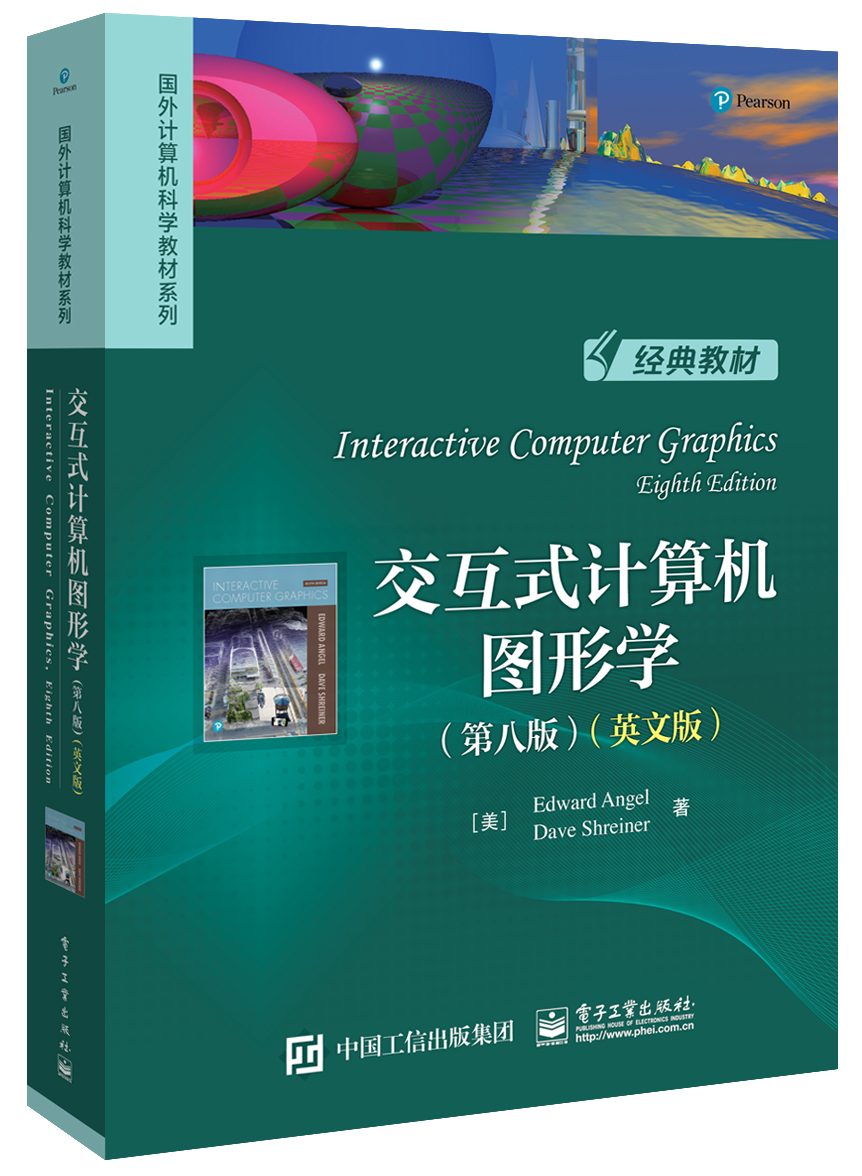数字图像处理(第三版)(英文版) / 国外电子与通信教材系列
¥89.00定价
作者: Rafael C. Gonzalez(拉斐尔 C. 冈萨雷斯),Richard E. Woods (理查德 E. 伍兹)
出版时间:2017-01
出版社:电子工业出版社
试读
- 电子工业出版社
- 9787121305405
- 1-1
- 294664
- 16开
- 2017-01
- 976
- 信息工程
- 本科 研究生(硕士、EMBA、MBA、MPA、博士)
内容简介
本书是关于数字图像处理的经典著作,作者在对32个国家的134所院校和研究所的教师、学生及自学者进行广泛调查的基础上编写了第三版。除保留第二版的大部分主要内容外,还根据收集的建议从13个方面进行了修订,新增了400多幅图像、200多个图表和80多道习题,同时融入了近年来本科学领域的重要发展,使本书具有鲜明的特色与时效性。全书共分12章,包括绪论、数字图像基础、灰度变换与空间滤波、频域滤波、图像复原与重建、彩色图像处理、小波及多分辨率处理、图像压缩、形态学图像处理、图像分割、表现与描述、目标识别。
目录
Preface 15
Acknowledgments 19
The Book Web Site 20
About the Authors 21
Chapter 1 Introduction 23
1.1 What Is Digital Image Processing? 23
1.2 The Origins of Digital Image Processing 25
1.3 Examples of Fields that Use Digital Image Processing 29
1.3.1 Gamma-Ray Imaging 30
1.3.2 X-Ray Imaging 31
1.3.3 Imaging in the Ultraviolet Band 33
1.3.4 Imaging in the Visible and Infrared Bands 34
1.3.5 Imaging in the Microwave Band 40
1.3.6 Imaging in the Radio Band 42
1.3.7 Examples in which Other Imaging Modalities Are Used 42
1.4 Fundamental Steps in Digital Image Processing 47
1.5 Components of an Image Processing System 50
Summary 53
References and Further Reading 53
Chapter 2 Digital Image Fundamentals 57
2.1 Elements of Visual Perception 58
2.1.1 Structure of the Human Eye 58
2.1.2 Image Formation in the Eye 60
2.1.3 Brightness Adaptation and Discrimination 61
2.2 Light and the Electromagnetic Spectrum 65
2.3 Image Sensing and Acquisition 68
2.3.1 Image Acquisition Using a Single Sensor 70
2.3.2 Image Acquisition Using Sensor Strips 70
2.3.3 Image Acquisition Using Sensor Arrays 72
2.3.4 A Simple Image Formation Model 72
2.4 Image Sampling and Quantization 74
2.4.1 Basic Concepts in Sampling and Quantization 74
2.4.2 Representing Digital Images 77
2.4.3 Spatial and Intensity Resolution 81
2.4.4 Image Interpolation 87
2.5 Some Basic Relationships between Pixels 90
2.5.1 Neighbors of a Pixel 90
2.5.2 Adjacency, Connectivity, Regions, and Boundaries 90
2.5.3 Distance Measures 93
2.6 An Introduction to the Mathematical Tools Used in Digital Image Processing 94
2.6.1 Array versus Matrix Operations 94
2.6.2 Linear versus Nonlinear Operations 95
2.6.3 Arithmetic Operations 96
2.6.4 Set and Logical Operations 102
2.6.5 Spatial Operations 107
2.6.6 Vector and Matrix Operations 114
2.6.7 Image Transforms 115
2.6.8 Probabilistic Methods 118
Summary 120
References and Further Reading 120
Problems 121
Chapter 3 Intensity Transformations and Spatial Filtering 126
3.1 Background 127
3.1.1 The Basics of Intensity Transformations and Spatial Filtering 127
3.1.2 About the Examples in This Chapter 129
3.2 Some Basic Intensity Transformation Functions 129
3.2.1 Image Negatives 130
3.2.2 Log Transformations 131
3.2.3 Power-Law (Gamma) Transformations 132
3.2.4 Piecewise-Linear Transformation Functions 137
3.3 Histogram Processing 142
3.3.1 Histogram Equalization 144
3.3.2 Histogram Matching (Specification) 150
3.3.3 Local Histogram Processing 161
3.3.4 Using Histogram Statistics for Image Enhancement 161
3.4 Fundamentals of Spatial Filtering 166
3.4.1 The Mechanics of Spatial Filtering 167
3.4.2 Spatial Correlation and Convolution 168
3.4.3 Vector Representation of Linear Filtering 172
3.4.4 Generating Spatial Filter Masks 173
3.5 Smoothing Spatial Filters 174
3.5.1 Smoothing Linear Filters 174
3.5.2 Order-Statistic (Nonlinear) Filters 178
3.6 Sharpening Spatial Filters 179
3.6.1 Foundation 180
3.6.2 Using the Second Derivative for Image Sharpening-The Laplacian 182
3.6.3 Unsharp Masking and Highboost Filtering 184
3.6.4 Using First-Order Derivatives for (Nonlinear) Image Sharpening—The Gradient 187
3.7 Combining Spatial Enhancement Methods 191
3.8 Using Fuzzy Techniques for Intensity Transformations and Spatial Filtering 195
3.8.1 Introduction 195
3.8.2 Principles of Fuzzy Set Theory 196
3.8.3 Using Fuzzy Sets 200
3.8.4 Using Fuzzy Sets for Intensity Transformations 208
3.8.5 Using Fuzzy Sets for Spatial Filtering 211
Summary 214
References and Further Reading 214
Problems 215
Chapter 4 Filtering in the Frequency Domain 221
4.1 Background 222
4.1.1 A Brief History of the Fourier Series and Transform 222
4.1.2 About the Examples in this Chapter 223
4.2 Preliminary Concepts 224
4.2.1 Complex Numbers 224
4.2.2 Fourier Series 225
4.2.3 Impulses and Their Sifting Property 225
4.2.4 The Fourier Transform of Functions of One Continuous Variable 227
4.2.5 Convolution 231
4.3 Sampling and the Fourier Transform of Sampled Functions 233
4.3.1 Sampling 233
4.3.2 The Fourier Transform of Sampled Functions 234
4.3.3 The Sampling Theorem 235
4.3.4 Aliasing 239
4.3.5 Function Reconstruction (Recovery) from Sampled Data 241
4.4 The Discrete Fourier Transform (DFT) of One Variable 242
4.4.1 Obtaining the DFT from the Continuous Transform of a Sampled Function 243
4.4.2 Relationship Between the Sampling and Frequency Intervals 245
4.5 Extension to Functions of Two Variables 247
4.5.1 The 2-D Impulse and Its Sifting Property 247
4.5.2 The 2-D Continuous Fourier Transform Pair 248
4.5.3 Two-Dimensional Sampling and the 2-D Sampling Theorem 249
4.5.4 Aliasing in Images 250
4.5.5 The 2-D Discrete Fourier Transform and Its Inverse 257
4.6 Some Properties of the 2-D Discrete Fourier Transform 258
4.6.1 Relationships Between Spatial and Frequency Intervals 258
4.6.2 Translation and Rotation 258
4.6.3 Periodicity 259
4.6.4 Symmetry Properties 261
4.6.5 Fourier Spectrum and Phase Angle 267
4.6.6 The 2-D Convolution Theorem 271
4.6.7 Summary of 2-D Discrete Fourier Transform Properties 275
4.7 The Basics of Filtering in the Frequency Domain 277
4.7.1 Additional Characteristics of the Frequency Domain 277
4.7.2 Frequency Domain Filtering Fundamentals 279
4.7.3 Summary of Steps for Filtering in the Frequency Domain 285
4.7.4 Correspondence Between Filtering in the Spatial and Frequency Domains 285
4.8 Image Smoothing Using Frequency Domain Filters 291
4.8.1 Ideal Lowpass Filters 291
4.8.2 Butterworth Lowpass Filters 295
4.8.3 Gaussian Lowpass Filters 298
4.8.4 Additional Examples of Lowpass Filtering 299
4.9 Image Sharpening Using Frequency Domain Filters 302
4.9.1 Ideal Highpass Filters 303
4.9.2 Butterworth Highpass Filters 306
4.9.3 Gaussian Highpass Filters 307
4.9.4 The Laplacian in the Frequency Domain 308
4.9.5 Unsharp Masking, Highboost Filtering, and High-Frequency-Emphasis Filtering 310
4.9.6 Homomorphic Filtering 311
4.10 Selective Filtering 316
4.10.1 Bandreject and Bandpass Filters 316
4.10.2 Notch Filters 316
4.11 Implementation 320
4.11.1 Separability of the 2-D DFT 320
4.11.2 Computing the IDFT Using a DFT Algorithm 321
4.11.3 The Fast Fourier Transform (FFT) 321
4.11.4 Some Comments on Filter Design 325
Summary 325
References and Further Reading 326
Problems 326
Chapter 5 Image Restoration and Reconstruction 333
5.1 A Model of the Image Degradation/Restoration Process 334
5.2 Noise Models 335
5.2.1 Spatial and Frequency Properties of Noise 335
5.2.2 Some Important Noise Probability Density Functions 336
5.2.3 Periodic Noise 340
5.2.4 Estimation of Noise Parameters 341
5.3 Restoration in the Presence of Noise Only—Spatial Filtering 344
5.3.1 Mean Filters 344
5.3.2 Order-Statistic Filters 347
5.3.3 Adaptive Filters 352
5.4 Periodic Noise Reduction by Frequency Domain Filtering 357
5.4.1 Bandreject Filters 357
5.4.2 Bandpass Filters 358
5.4.3 Notch Filters 359
5.4.4 Optimum Notch Filtering 360
5.5 Linear, Position-Invariant Degradations 365
5.6 Estimating the Degradation Function 368
5.6.1 Estimation by Image Observation 368
5.6.2 Estimation by Experimentation 369
5.6.3 Estimation by Modeling 369
5.7 Inverse Filtering 373
5.8 Minimum Mean Square Error (Wiener) Filtering 374
5.9 Constrained Least Squares Filtering 379
5.10 Geometric Mean Filter 383
5.11 Image Reconstruction from Projections 384
5.11.1 Introduction 384
5.11.2 Principles of Computed Tomography (CT) 387
5.11.3 Projections and the Radon Transform 390
5.11.4 The Fourier-Slice Theorem 396
5.11.5 Reconstruction Using Parallel-Beam Filtered Backprojections 397
5.11.6 Reconstruction Using Fan-Beam Filtered Backprojections 403
Summary 409
References and Further Reading 410
Problems 411
Chapter 6 Color Image Processing 416
6.1 Color Fundamentals 417
6.2 Color Models 423
6.2.1 The RGB Color Model 424
6.2.2 The CMY and CMYK Color Models 428
6.2.3 The HSI Color Model 429
6.3 Pseudocolor Image Processing 436
6.3.1 Intensity Slicing 437
6.3.2 Intensity to Color Transformations 440
6.4 Basics of Full-Color Image Processing 446
6.5 Color Transformations 448
6.5.1 Formulation 448
6.5.2 Color Complements 452
6.5.3 Color Slicing 453
6.5.4 Tone and Color Corrections 455
6.5.5 Histogram Processing 460
6.6 Smoothing and Sharpening 461
6.6.1 Color Image Smoothing 461
6.6.2 Color Image Sharpening 464
6.7 Image Segmentation Based on Color 465
6.7.1 Segmentation in HSI Color Space 465
6.7.2 Segmentation in RGB Vector Space 467
6.7.3 Color Edge Detection 469
6.8 Noise in Color Images 473
6.9 Color Image Compression 476
Summary 477
References and Further Reading 478
Problems 478
Chapter 7 Wavelets and Multiresolution Processing 483
7.1 Background 484
7.1.1 Image Pyramids 485
7.1.2 Subband Coding 488
7.1.3 The Haar Transform 496
7.2 Multiresolution Expansions 499
7.2.1 Series Expansions 499
7.2.2 Scaling Functions 501
7.2.3 Wavelet Functions 505
7.3 Wavelet Transforms in One Dimension 508
7.3.1 The Wavelet Series Expansions 508
7.3.2 The Discrete Wavelet Transform 510
7.3.3 The Continuous Wavelet Transform 513
7.4 The Fast Wavelet Transform 515
7.5 Wavelet Transforms in Two Dimensions 523
7.6 Wavelet Packets 532
Summary 542
References and Further Reading 542
Problems 543
Chapter 8 Image Compression 547
8.1 Fundamentals 548
8.1.1 Coding Redundancy 550
8.1.2 Spatial and Temporal Redundancy 551
8.1.3 Irrelevant Information 552
8.1.4 Measuring Image Information 553
8.1.5 Fidelity Criteria 556
8.1.6 Image Compression Models 558
8.1.7 Image Formats, Containers, and Compression Standards 560
8.2 Some Basic Compression Methods 564
8.2.1 Huffman Coding 564
8.2.2 Golomb Coding 566
8.2.3 Arithmetic Coding 570
8.2.4 LZW Coding 573
8.2.5 Run-Length Coding 575
8.2.6 Symbol-Based Coding 581
8.2.7 Bit-Plane Coding 584
8.2.8 Block Transform Coding 588
8.2.9 Predictive Coding 606
8.2.10 Wavelet Coding 626
8.3 Digital Image Watermarking 636
Summary 643
References and Further Reading 644
Problems 645
Chapter 9 Morphological Image Processing 649
9.1 Preliminaries 650
9.2 Erosion and Dilation 652
9.2.1 Erosion 653
9.2.2 Dilation 655
9.2.3 Duality 657
9.3 Opening and Closing 657
9.4 The Hit-or-Miss Transformation 662
9.5 Some Basic Morphological Algorithms 664
9.5.1 Boundary Extraction 664
9.5.2 Hole Filling 665
9.5.3 Extraction of Connected Components 667
9.5.4 Convex Hull 669
9.5.5 Thinning 671
9.5.6 Thickening 672
9.5.7 Skeletons 673
9.5.8 Pruning 676
9.5.9 Morphological Reconstruction 678
9.5.10 Summary of Morphological Operations on Binary Images 684
9.6 Gray-Scale Morphology 687
9.6.1 Erosion and Dilation 688
9.6.2 Opening and Closing 690
9.6.3 Some Basic Gray-Scale Morphological Algorithms 692
9.6.4 Gray-Scale Morphological Reconstruction 698
Summary 701
References and Further Reading 701
Problems 702
Chapter 10 Image Segmentation 711
10.1 Fundamentals 712
10.2 Point, Line, and Edge Detection 714
10.2.1 Background 714
10.2.2 Detection of Isolated Points 718
10.2.3 Line Detection 719
10.2.4 Edge Models 722
10.2.5 Basic Edge Detection 728
10.2.6 More Advanced Techniques for Edge Detection 736
10.2.7 Edge Linking and Boundary Detection 747
10.3 Thresholding 760
10.3.1 Foundation 760
10.3.2 Basic Global Thresholding 763
10.3.3 Optimum Global Thresholding Using Otsu’s Method 764
10.3.4 Using Image Smoothing to Improve Global Thresholding 769
10.3.5 Using Edges to Improve Global Thresholding 771
10.3.6 Multiple Thresholds 774
10.3.7 Variable Thresholding 778
10.3.8 Multivariable Thresholding 783
10.4 Region-Based Segmentation 785
10.4.1 Region Growing 785
10.4.2 Region Splitting and Merging 788
10.5 Segmentation Using Morphological Watersheds 791
10.5.1 Background 791
10.5.2 Dam Construction 794
10.5.3 Watershed Segmentation Algorithm 796
10.5.4 The Use of Markers 798
10.6 The Use of Motion in Segmentation 800
10.6.1 Spatial Techniques 800
10.6.2 Frequency Domain Techniques 804
Summary 807
References and Further Reading 807
Problems 809
Chapter 11 Representation and Description 817
11.1 Representation 818
11.1.1 Boundary (Border) Following 818
11.1.2 Chain Codes 820
11.1.3 Polygonal Approximations Using Minimum-Perimeter Polygons 823
11.1.4 Other Polygonal Approximation Approaches 829
11.1.5 Signatures 830
11.1.6 Boundary Segments 832
11.1.7 Skeletons 834
11.2 Boundary Descriptors 837
11.2.1 Some Simple Descriptors 837
11.2.2 Shape Numbers 838
11.2.3 Fourier Descriptors 840
11.2.4 Statistical Moments 843
11.3 Regional Descriptors 844
11.3.1 Some Simple Descriptors 844
11.3.2 Topological Descriptors 845
11.3.3 Texture 849
11.3.4 Moment Invariants 861
11.4 Use of Principal Components for Description 864
11.5 Relational Descriptors 874
Summary 878
References and Further Reading 878
Problems 879
Chapter 12 Object Recognition 883
12.1 Patterns and Pattern Classes 883
12.2 Recognition Based on Decision-Theoretic Methods 888
12.2.1 Matching 888
12.2.2 Optimum Statistical Classifiers 894
12.2.3 Neural Networks 904
12.3 Structural Methods 925
12.3.1 Matching Shape Numbers 925
12.3.2 String Matching 926
Summary 928
References and Further Reading 928
Problems 929
Appendix A 932
Bibliography 937
Index 965
Acknowledgments 19
The Book Web Site 20
About the Authors 21
Chapter 1 Introduction 23
1.1 What Is Digital Image Processing? 23
1.2 The Origins of Digital Image Processing 25
1.3 Examples of Fields that Use Digital Image Processing 29
1.3.1 Gamma-Ray Imaging 30
1.3.2 X-Ray Imaging 31
1.3.3 Imaging in the Ultraviolet Band 33
1.3.4 Imaging in the Visible and Infrared Bands 34
1.3.5 Imaging in the Microwave Band 40
1.3.6 Imaging in the Radio Band 42
1.3.7 Examples in which Other Imaging Modalities Are Used 42
1.4 Fundamental Steps in Digital Image Processing 47
1.5 Components of an Image Processing System 50
Summary 53
References and Further Reading 53
Chapter 2 Digital Image Fundamentals 57
2.1 Elements of Visual Perception 58
2.1.1 Structure of the Human Eye 58
2.1.2 Image Formation in the Eye 60
2.1.3 Brightness Adaptation and Discrimination 61
2.2 Light and the Electromagnetic Spectrum 65
2.3 Image Sensing and Acquisition 68
2.3.1 Image Acquisition Using a Single Sensor 70
2.3.2 Image Acquisition Using Sensor Strips 70
2.3.3 Image Acquisition Using Sensor Arrays 72
2.3.4 A Simple Image Formation Model 72
2.4 Image Sampling and Quantization 74
2.4.1 Basic Concepts in Sampling and Quantization 74
2.4.2 Representing Digital Images 77
2.4.3 Spatial and Intensity Resolution 81
2.4.4 Image Interpolation 87
2.5 Some Basic Relationships between Pixels 90
2.5.1 Neighbors of a Pixel 90
2.5.2 Adjacency, Connectivity, Regions, and Boundaries 90
2.5.3 Distance Measures 93
2.6 An Introduction to the Mathematical Tools Used in Digital Image Processing 94
2.6.1 Array versus Matrix Operations 94
2.6.2 Linear versus Nonlinear Operations 95
2.6.3 Arithmetic Operations 96
2.6.4 Set and Logical Operations 102
2.6.5 Spatial Operations 107
2.6.6 Vector and Matrix Operations 114
2.6.7 Image Transforms 115
2.6.8 Probabilistic Methods 118
Summary 120
References and Further Reading 120
Problems 121
Chapter 3 Intensity Transformations and Spatial Filtering 126
3.1 Background 127
3.1.1 The Basics of Intensity Transformations and Spatial Filtering 127
3.1.2 About the Examples in This Chapter 129
3.2 Some Basic Intensity Transformation Functions 129
3.2.1 Image Negatives 130
3.2.2 Log Transformations 131
3.2.3 Power-Law (Gamma) Transformations 132
3.2.4 Piecewise-Linear Transformation Functions 137
3.3 Histogram Processing 142
3.3.1 Histogram Equalization 144
3.3.2 Histogram Matching (Specification) 150
3.3.3 Local Histogram Processing 161
3.3.4 Using Histogram Statistics for Image Enhancement 161
3.4 Fundamentals of Spatial Filtering 166
3.4.1 The Mechanics of Spatial Filtering 167
3.4.2 Spatial Correlation and Convolution 168
3.4.3 Vector Representation of Linear Filtering 172
3.4.4 Generating Spatial Filter Masks 173
3.5 Smoothing Spatial Filters 174
3.5.1 Smoothing Linear Filters 174
3.5.2 Order-Statistic (Nonlinear) Filters 178
3.6 Sharpening Spatial Filters 179
3.6.1 Foundation 180
3.6.2 Using the Second Derivative for Image Sharpening-The Laplacian 182
3.6.3 Unsharp Masking and Highboost Filtering 184
3.6.4 Using First-Order Derivatives for (Nonlinear) Image Sharpening—The Gradient 187
3.7 Combining Spatial Enhancement Methods 191
3.8 Using Fuzzy Techniques for Intensity Transformations and Spatial Filtering 195
3.8.1 Introduction 195
3.8.2 Principles of Fuzzy Set Theory 196
3.8.3 Using Fuzzy Sets 200
3.8.4 Using Fuzzy Sets for Intensity Transformations 208
3.8.5 Using Fuzzy Sets for Spatial Filtering 211
Summary 214
References and Further Reading 214
Problems 215
Chapter 4 Filtering in the Frequency Domain 221
4.1 Background 222
4.1.1 A Brief History of the Fourier Series and Transform 222
4.1.2 About the Examples in this Chapter 223
4.2 Preliminary Concepts 224
4.2.1 Complex Numbers 224
4.2.2 Fourier Series 225
4.2.3 Impulses and Their Sifting Property 225
4.2.4 The Fourier Transform of Functions of One Continuous Variable 227
4.2.5 Convolution 231
4.3 Sampling and the Fourier Transform of Sampled Functions 233
4.3.1 Sampling 233
4.3.2 The Fourier Transform of Sampled Functions 234
4.3.3 The Sampling Theorem 235
4.3.4 Aliasing 239
4.3.5 Function Reconstruction (Recovery) from Sampled Data 241
4.4 The Discrete Fourier Transform (DFT) of One Variable 242
4.4.1 Obtaining the DFT from the Continuous Transform of a Sampled Function 243
4.4.2 Relationship Between the Sampling and Frequency Intervals 245
4.5 Extension to Functions of Two Variables 247
4.5.1 The 2-D Impulse and Its Sifting Property 247
4.5.2 The 2-D Continuous Fourier Transform Pair 248
4.5.3 Two-Dimensional Sampling and the 2-D Sampling Theorem 249
4.5.4 Aliasing in Images 250
4.5.5 The 2-D Discrete Fourier Transform and Its Inverse 257
4.6 Some Properties of the 2-D Discrete Fourier Transform 258
4.6.1 Relationships Between Spatial and Frequency Intervals 258
4.6.2 Translation and Rotation 258
4.6.3 Periodicity 259
4.6.4 Symmetry Properties 261
4.6.5 Fourier Spectrum and Phase Angle 267
4.6.6 The 2-D Convolution Theorem 271
4.6.7 Summary of 2-D Discrete Fourier Transform Properties 275
4.7 The Basics of Filtering in the Frequency Domain 277
4.7.1 Additional Characteristics of the Frequency Domain 277
4.7.2 Frequency Domain Filtering Fundamentals 279
4.7.3 Summary of Steps for Filtering in the Frequency Domain 285
4.7.4 Correspondence Between Filtering in the Spatial and Frequency Domains 285
4.8 Image Smoothing Using Frequency Domain Filters 291
4.8.1 Ideal Lowpass Filters 291
4.8.2 Butterworth Lowpass Filters 295
4.8.3 Gaussian Lowpass Filters 298
4.8.4 Additional Examples of Lowpass Filtering 299
4.9 Image Sharpening Using Frequency Domain Filters 302
4.9.1 Ideal Highpass Filters 303
4.9.2 Butterworth Highpass Filters 306
4.9.3 Gaussian Highpass Filters 307
4.9.4 The Laplacian in the Frequency Domain 308
4.9.5 Unsharp Masking, Highboost Filtering, and High-Frequency-Emphasis Filtering 310
4.9.6 Homomorphic Filtering 311
4.10 Selective Filtering 316
4.10.1 Bandreject and Bandpass Filters 316
4.10.2 Notch Filters 316
4.11 Implementation 320
4.11.1 Separability of the 2-D DFT 320
4.11.2 Computing the IDFT Using a DFT Algorithm 321
4.11.3 The Fast Fourier Transform (FFT) 321
4.11.4 Some Comments on Filter Design 325
Summary 325
References and Further Reading 326
Problems 326
Chapter 5 Image Restoration and Reconstruction 333
5.1 A Model of the Image Degradation/Restoration Process 334
5.2 Noise Models 335
5.2.1 Spatial and Frequency Properties of Noise 335
5.2.2 Some Important Noise Probability Density Functions 336
5.2.3 Periodic Noise 340
5.2.4 Estimation of Noise Parameters 341
5.3 Restoration in the Presence of Noise Only—Spatial Filtering 344
5.3.1 Mean Filters 344
5.3.2 Order-Statistic Filters 347
5.3.3 Adaptive Filters 352
5.4 Periodic Noise Reduction by Frequency Domain Filtering 357
5.4.1 Bandreject Filters 357
5.4.2 Bandpass Filters 358
5.4.3 Notch Filters 359
5.4.4 Optimum Notch Filtering 360
5.5 Linear, Position-Invariant Degradations 365
5.6 Estimating the Degradation Function 368
5.6.1 Estimation by Image Observation 368
5.6.2 Estimation by Experimentation 369
5.6.3 Estimation by Modeling 369
5.7 Inverse Filtering 373
5.8 Minimum Mean Square Error (Wiener) Filtering 374
5.9 Constrained Least Squares Filtering 379
5.10 Geometric Mean Filter 383
5.11 Image Reconstruction from Projections 384
5.11.1 Introduction 384
5.11.2 Principles of Computed Tomography (CT) 387
5.11.3 Projections and the Radon Transform 390
5.11.4 The Fourier-Slice Theorem 396
5.11.5 Reconstruction Using Parallel-Beam Filtered Backprojections 397
5.11.6 Reconstruction Using Fan-Beam Filtered Backprojections 403
Summary 409
References and Further Reading 410
Problems 411
Chapter 6 Color Image Processing 416
6.1 Color Fundamentals 417
6.2 Color Models 423
6.2.1 The RGB Color Model 424
6.2.2 The CMY and CMYK Color Models 428
6.2.3 The HSI Color Model 429
6.3 Pseudocolor Image Processing 436
6.3.1 Intensity Slicing 437
6.3.2 Intensity to Color Transformations 440
6.4 Basics of Full-Color Image Processing 446
6.5 Color Transformations 448
6.5.1 Formulation 448
6.5.2 Color Complements 452
6.5.3 Color Slicing 453
6.5.4 Tone and Color Corrections 455
6.5.5 Histogram Processing 460
6.6 Smoothing and Sharpening 461
6.6.1 Color Image Smoothing 461
6.6.2 Color Image Sharpening 464
6.7 Image Segmentation Based on Color 465
6.7.1 Segmentation in HSI Color Space 465
6.7.2 Segmentation in RGB Vector Space 467
6.7.3 Color Edge Detection 469
6.8 Noise in Color Images 473
6.9 Color Image Compression 476
Summary 477
References and Further Reading 478
Problems 478
Chapter 7 Wavelets and Multiresolution Processing 483
7.1 Background 484
7.1.1 Image Pyramids 485
7.1.2 Subband Coding 488
7.1.3 The Haar Transform 496
7.2 Multiresolution Expansions 499
7.2.1 Series Expansions 499
7.2.2 Scaling Functions 501
7.2.3 Wavelet Functions 505
7.3 Wavelet Transforms in One Dimension 508
7.3.1 The Wavelet Series Expansions 508
7.3.2 The Discrete Wavelet Transform 510
7.3.3 The Continuous Wavelet Transform 513
7.4 The Fast Wavelet Transform 515
7.5 Wavelet Transforms in Two Dimensions 523
7.6 Wavelet Packets 532
Summary 542
References and Further Reading 542
Problems 543
Chapter 8 Image Compression 547
8.1 Fundamentals 548
8.1.1 Coding Redundancy 550
8.1.2 Spatial and Temporal Redundancy 551
8.1.3 Irrelevant Information 552
8.1.4 Measuring Image Information 553
8.1.5 Fidelity Criteria 556
8.1.6 Image Compression Models 558
8.1.7 Image Formats, Containers, and Compression Standards 560
8.2 Some Basic Compression Methods 564
8.2.1 Huffman Coding 564
8.2.2 Golomb Coding 566
8.2.3 Arithmetic Coding 570
8.2.4 LZW Coding 573
8.2.5 Run-Length Coding 575
8.2.6 Symbol-Based Coding 581
8.2.7 Bit-Plane Coding 584
8.2.8 Block Transform Coding 588
8.2.9 Predictive Coding 606
8.2.10 Wavelet Coding 626
8.3 Digital Image Watermarking 636
Summary 643
References and Further Reading 644
Problems 645
Chapter 9 Morphological Image Processing 649
9.1 Preliminaries 650
9.2 Erosion and Dilation 652
9.2.1 Erosion 653
9.2.2 Dilation 655
9.2.3 Duality 657
9.3 Opening and Closing 657
9.4 The Hit-or-Miss Transformation 662
9.5 Some Basic Morphological Algorithms 664
9.5.1 Boundary Extraction 664
9.5.2 Hole Filling 665
9.5.3 Extraction of Connected Components 667
9.5.4 Convex Hull 669
9.5.5 Thinning 671
9.5.6 Thickening 672
9.5.7 Skeletons 673
9.5.8 Pruning 676
9.5.9 Morphological Reconstruction 678
9.5.10 Summary of Morphological Operations on Binary Images 684
9.6 Gray-Scale Morphology 687
9.6.1 Erosion and Dilation 688
9.6.2 Opening and Closing 690
9.6.3 Some Basic Gray-Scale Morphological Algorithms 692
9.6.4 Gray-Scale Morphological Reconstruction 698
Summary 701
References and Further Reading 701
Problems 702
Chapter 10 Image Segmentation 711
10.1 Fundamentals 712
10.2 Point, Line, and Edge Detection 714
10.2.1 Background 714
10.2.2 Detection of Isolated Points 718
10.2.3 Line Detection 719
10.2.4 Edge Models 722
10.2.5 Basic Edge Detection 728
10.2.6 More Advanced Techniques for Edge Detection 736
10.2.7 Edge Linking and Boundary Detection 747
10.3 Thresholding 760
10.3.1 Foundation 760
10.3.2 Basic Global Thresholding 763
10.3.3 Optimum Global Thresholding Using Otsu’s Method 764
10.3.4 Using Image Smoothing to Improve Global Thresholding 769
10.3.5 Using Edges to Improve Global Thresholding 771
10.3.6 Multiple Thresholds 774
10.3.7 Variable Thresholding 778
10.3.8 Multivariable Thresholding 783
10.4 Region-Based Segmentation 785
10.4.1 Region Growing 785
10.4.2 Region Splitting and Merging 788
10.5 Segmentation Using Morphological Watersheds 791
10.5.1 Background 791
10.5.2 Dam Construction 794
10.5.3 Watershed Segmentation Algorithm 796
10.5.4 The Use of Markers 798
10.6 The Use of Motion in Segmentation 800
10.6.1 Spatial Techniques 800
10.6.2 Frequency Domain Techniques 804
Summary 807
References and Further Reading 807
Problems 809
Chapter 11 Representation and Description 817
11.1 Representation 818
11.1.1 Boundary (Border) Following 818
11.1.2 Chain Codes 820
11.1.3 Polygonal Approximations Using Minimum-Perimeter Polygons 823
11.1.4 Other Polygonal Approximation Approaches 829
11.1.5 Signatures 830
11.1.6 Boundary Segments 832
11.1.7 Skeletons 834
11.2 Boundary Descriptors 837
11.2.1 Some Simple Descriptors 837
11.2.2 Shape Numbers 838
11.2.3 Fourier Descriptors 840
11.2.4 Statistical Moments 843
11.3 Regional Descriptors 844
11.3.1 Some Simple Descriptors 844
11.3.2 Topological Descriptors 845
11.3.3 Texture 849
11.3.4 Moment Invariants 861
11.4 Use of Principal Components for Description 864
11.5 Relational Descriptors 874
Summary 878
References and Further Reading 878
Problems 879
Chapter 12 Object Recognition 883
12.1 Patterns and Pattern Classes 883
12.2 Recognition Based on Decision-Theoretic Methods 888
12.2.1 Matching 888
12.2.2 Optimum Statistical Classifiers 894
12.2.3 Neural Networks 904
12.3 Structural Methods 925
12.3.1 Matching Shape Numbers 925
12.3.2 String Matching 926
Summary 928
References and Further Reading 928
Problems 929
Appendix A 932
Bibliography 937
Index 965










